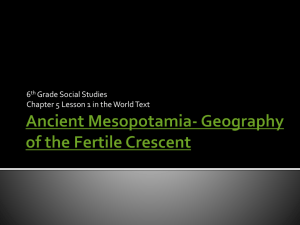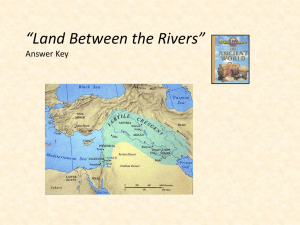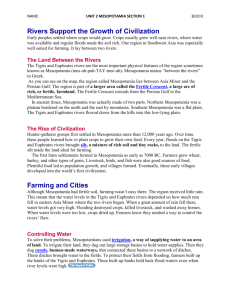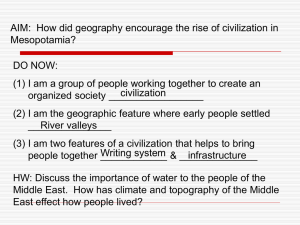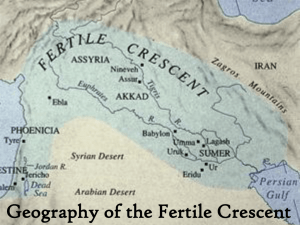Ancient Mesopotamia: Geography of the Fertile Crescent
advertisement
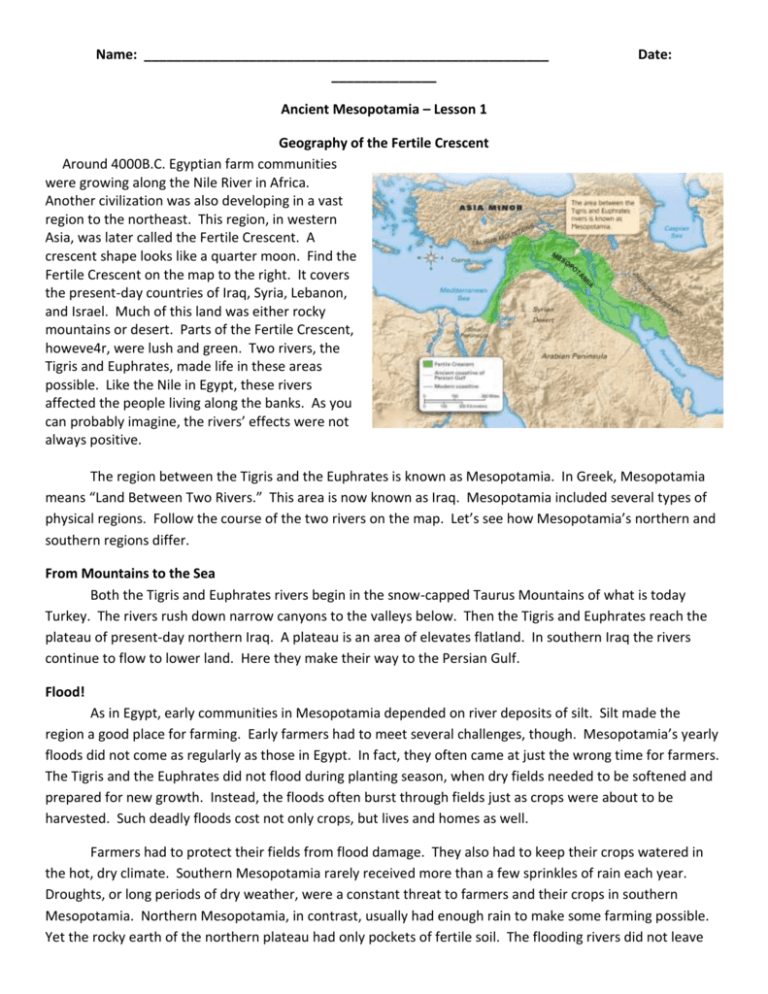
Name: ______________________________________________________ ______________ Date: Ancient Mesopotamia – Lesson 1 Geography of the Fertile Crescent Around 4000B.C. Egyptian farm communities were growing along the Nile River in Africa. Another civilization was also developing in a vast region to the northeast. This region, in western Asia, was later called the Fertile Crescent. A crescent shape looks like a quarter moon. Find the Fertile Crescent on the map to the right. It covers the present-day countries of Iraq, Syria, Lebanon, and Israel. Much of this land was either rocky mountains or desert. Parts of the Fertile Crescent, howeve4r, were lush and green. Two rivers, the Tigris and Euphrates, made life in these areas possible. Like the Nile in Egypt, these rivers affected the people living along the banks. As you can probably imagine, the rivers’ effects were not always positive. The region between the Tigris and the Euphrates is known as Mesopotamia. In Greek, Mesopotamia means “Land Between Two Rivers.” This area is now known as Iraq. Mesopotamia included several types of physical regions. Follow the course of the two rivers on the map. Let’s see how Mesopotamia’s northern and southern regions differ. From Mountains to the Sea Both the Tigris and Euphrates rivers begin in the snow-capped Taurus Mountains of what is today Turkey. The rivers rush down narrow canyons to the valleys below. Then the Tigris and Euphrates reach the plateau of present-day northern Iraq. A plateau is an area of elevates flatland. In southern Iraq the rivers continue to flow to lower land. Here they make their way to the Persian Gulf. Flood! As in Egypt, early communities in Mesopotamia depended on river deposits of silt. Silt made the region a good place for farming. Early farmers had to meet several challenges, though. Mesopotamia’s yearly floods did not come as regularly as those in Egypt. In fact, they often came at just the wrong time for farmers. The Tigris and the Euphrates did not flood during planting season, when dry fields needed to be softened and prepared for new growth. Instead, the floods often burst through fields just as crops were about to be harvested. Such deadly floods cost not only crops, but lives and homes as well. Farmers had to protect their fields from flood damage. They also had to keep their crops watered in the hot, dry climate. Southern Mesopotamia rarely received more than a few sprinkles of rain each year. Droughts, or long periods of dry weather, were a constant threat to farmers and their crops in southern Mesopotamia. Northern Mesopotamia, in contrast, usually had enough rain to make some farming possible. Yet the rocky earth of the northern plateau had only pockets of fertile soil. The flooding rivers did not leave behind as much silt here in the north as to the south. For this reason southern Mesopotamia became better known for its fertile fields than northern Mesopotamia. Question Time: Answer the following questions based on what you just read above. 1. Where do the Tigris and Euphrates rivers begin? 2. Where is the plateau they flow through? 3. How did Mesopotamia’s floods benefit farmers there? 4. How did floods bring misfortune too? From Rivers to Field In the fall farmers in southern Mesopotamia needed water to plant and raise new crops. Unfortunately, fall was the time when the Tigris and the Euphrates were at their lowest. Spring was harvest time in ancient Mesopotamia. However, it was also the time when the rivers flooded their banks. Then farmers often got more water than they wanted. To solve these difficulties, ancient farmers learned to build water-control and irrigation systems. Farming in Ancient Mesopotamia Early Mesopotamian farmers grew many different crops. If you were able to go back there in time, you would see fields of wheat and barley. These were the region’s most important crops. You would also see gardens of beans, onions, lettuce, cucumbers, and spice plants. Ancient farmers also grew date palm, apple, and pomegranate trees. Because crops and trees need plenty of water, Mesopotamian farmers often planted them along canal banks. In the distance, on the edges of village farmland, you might see shepherds caring for sheep and goats. Shepherds also had to ward off attacks from wild animals such as lions and jackals. Sheep were especially prized in Mesopotamia for their milk and wool. Ancient Mesopotamians also valued cattle. Cattle were good work-animals, besides being used for milk, leather, and meat. Question Time: Answer the following questions based on what you just read above. 5. How was the Mesopotamian diet enriched by what they grew? 6. How did the animals they raised enrich their diet and their clothing? Why it Matters The region called Mesopotamia is not naturally an inviting place to live. Yet it was here that one of the world’s earliest civilizations developed. Water and soil brought by the Tigris and the Euphrates helped to make this civilization possible. Even more important were the farmers of ancient Mesopotamia. These early farmers figured out how to use the two rivers to make the land more fertile. As in some other early cultures, the farmers of Mesopotamia produced surplus crops. These surpluses allowed for specialization, which in turn led to the growth of towns and cities. The early cities formed a great civilization. As you will see, the legacy of early Mesopotamian civilization reaches even into our own times. Main Ideas Mesopotamia is the region between the Tigris and Euphrates rivers. It divided into a rugged plateau to the north and fertile plains to the south. Like the Nile River, the Tigris and the Euphrates flooded each year. These floods brought water and silt to Mesopotamia. Unlike those in Egypt, floods in Mesopotamia were often destructive and badly timed for farmers. Mesopotamian farmers used canal systems to control dangerous flooding, making their land productive. Question Time: Answer the following questions based on what you just read above. 7. What were the main crops grown in ancient Mesopotamia? What other foods were grown there? 8. Why was the timing of spring floods so important to farmers in ancient Mesopotamia? What could happen to crops if the floods came a little earlier than expected? 9. In what ways did Mesopotamian farmers adapt to and change their environment? 10. Suppose you lived in ancient Mesopotamia. Write a poem about the Tigris and Euphrates rivers from a farmer’s point of view.

